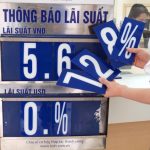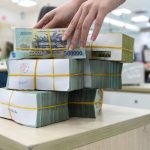
Easing exchange rate pressure allows SBV to be more flexible in monetary policy management
In their report on the macroeconomy, experts from VNDirect assessed that the State Bank of Vietnam (SBV) has made a notable shift in monetary policy in early August after reducing both OMO interest rates and bill rates to 4.25% per annum from the previous 4.5%.
This interest rate cut reversed the trend of rate hikes in the first half of 2024, when both OMO rates and bill rates were raised to 4.5% from 4.0% and 3.9%, respectively, at the beginning of the year.
VNDirect believes that this move comes as easing exchange rate pressure has given the SBV more flexibility in monetary policy management. As a result, the central bank will have more policy space to support market liquidity through open market operations and conditions to replenish foreign exchange reserves in the latter part of this year.
The US Dollar Index (DXY) witnessed a sharp decline in July and early August as US economic data came in weaker than expected. The US CPI rose 0.2% in July 2024, compared to a 0.1% decline in June 2024, in line with forecasts, and increased 2.9% year-on-year.
Meanwhile, the core personal consumption expenditure (PCE) price index, the Fed’s preferred inflation measure, rose only 0.1% from the previous month and 3.3% from a year earlier.
Notably, US non-farm payrolls fell to 114,000 in July 2024, compared to a revised 179,000 in June 2024 and a forecast of 185,000. The unemployment rate rose to 4.3%, the highest since October 2021.
After the release of the disappointing jobs report, the DXY fell below the 103 level before a slight recovery, while market expectations of a 25-basis-point Fed rate cut in September 2024 fell to 26.5% from over 90% previously as expectations for a higher 50-basis-point cut surged to 73.5% on August 5.
The recent sharp decline in the DXY has not only eased the USD/VND exchange rate pressure but also supported the exchange rates of other currencies in the region. Since the beginning of the year, while the VND has depreciated by 3.4% against the USD, the Chinese yuan (-0.7% year-to-date), the Indonesian rupiah (-3.5% year-to-date), the Malaysian ringgit (+3.9% year-to-date), and the Thai baht (-2.9% year-to-date) have also seen movements.
If the SBV had to sell about $6 billion in foreign exchange reserves to curb exchange rate increases in the first half of 2024, pressure from the foreign exchange market has eased considerably since then, mainly due to the weakness in the DXY and the narrowing gold price gap following SBV’s interventions.
As a result, at the beginning of August, the SBV reduced OMO and bill interest rates. Overall, VNDirect forecasts that the exchange rate will continue to ease towards the end of the year, with expectations of the Fed starting to cut rates from September, thus weakening the US dollar further. Vietnam continues to record a high trade surplus of $14.5 billion in the first seven months of 2024, with a robust 8.4% year-on-year increase in FDI disbursements and expectations of strong remittances in the fourth quarter.

With the current favorable developments, VNDirect forecasts that the USD/VND interbank exchange rate will fall below 25,000 VND earlier than expected in the positive scenario.
As of August 9, the average 12-month deposit interest rate of commercial banks increased to 4.96% per annum, up 0.05 percentage points from the beginning of the month and 0.02 percentage points year-to-date. While deposit rates rose moderately in July due to credit growth of only 5.66% year-to-date, the pace of deposit rate increases has picked up since the beginning of the month, with the 12-month deposit rate now 0.02 percentage points higher than at the end of 2023.
Meanwhile, credit grew by 5.66% as of the end of July, down 0.34 percentage points from 6.0% in the first half of 2024. However, credit has improved from 5.3% as of July 17 (-0.7 percentage points from 6.0% in the first half of 2024). This indicates that credit growth has recovered since the middle of July, so deposit rates continue to rise moderately in July.
VNDirect expects the pace of deposit rate increases to slow towards the end of the year and will be mainly driven by credit growth prospects. Therefore, they adjust their forecast for the average 12-month deposit rate to increase to 5.2-5.3% by the end of this year, lower than the previous forecast of 5.3-5.5% in the mid-year strategic report. This change is based on the possibility that the Fed will cut rates more than previously expected, which means the SBV will have more room to manage monetary policy flexibly.
Reflecting on a year of free-falling interest rates
Savings interest rates in 2023 witnessed a race to the lowest levels in 20 years, dropping from a peak of 12% per year for the 12-month term in early 2023 to below 5% per year by the end of the year. Let’s take a closer look at the unprecedented interest rate developments of the past year with Tiền Phong.


















